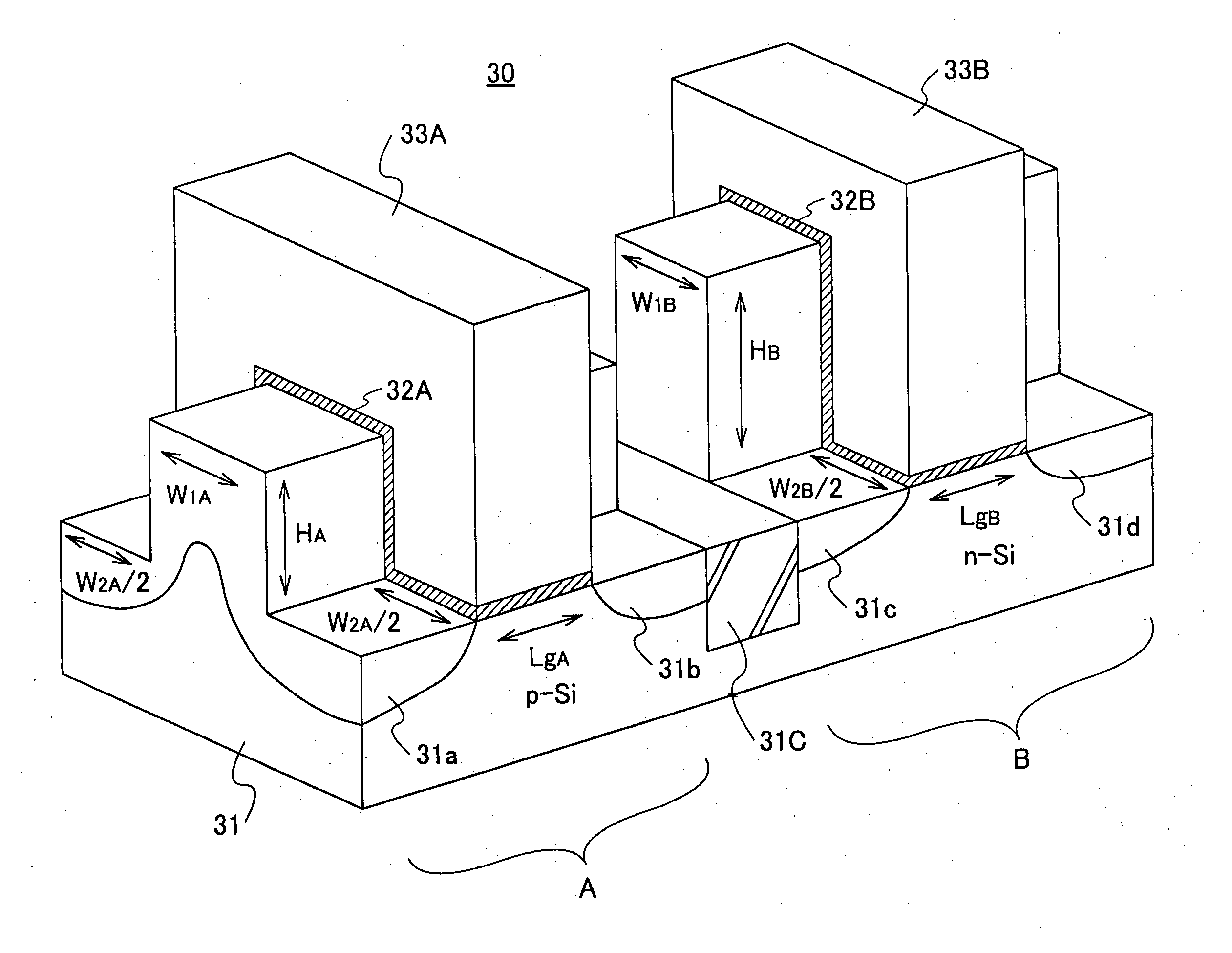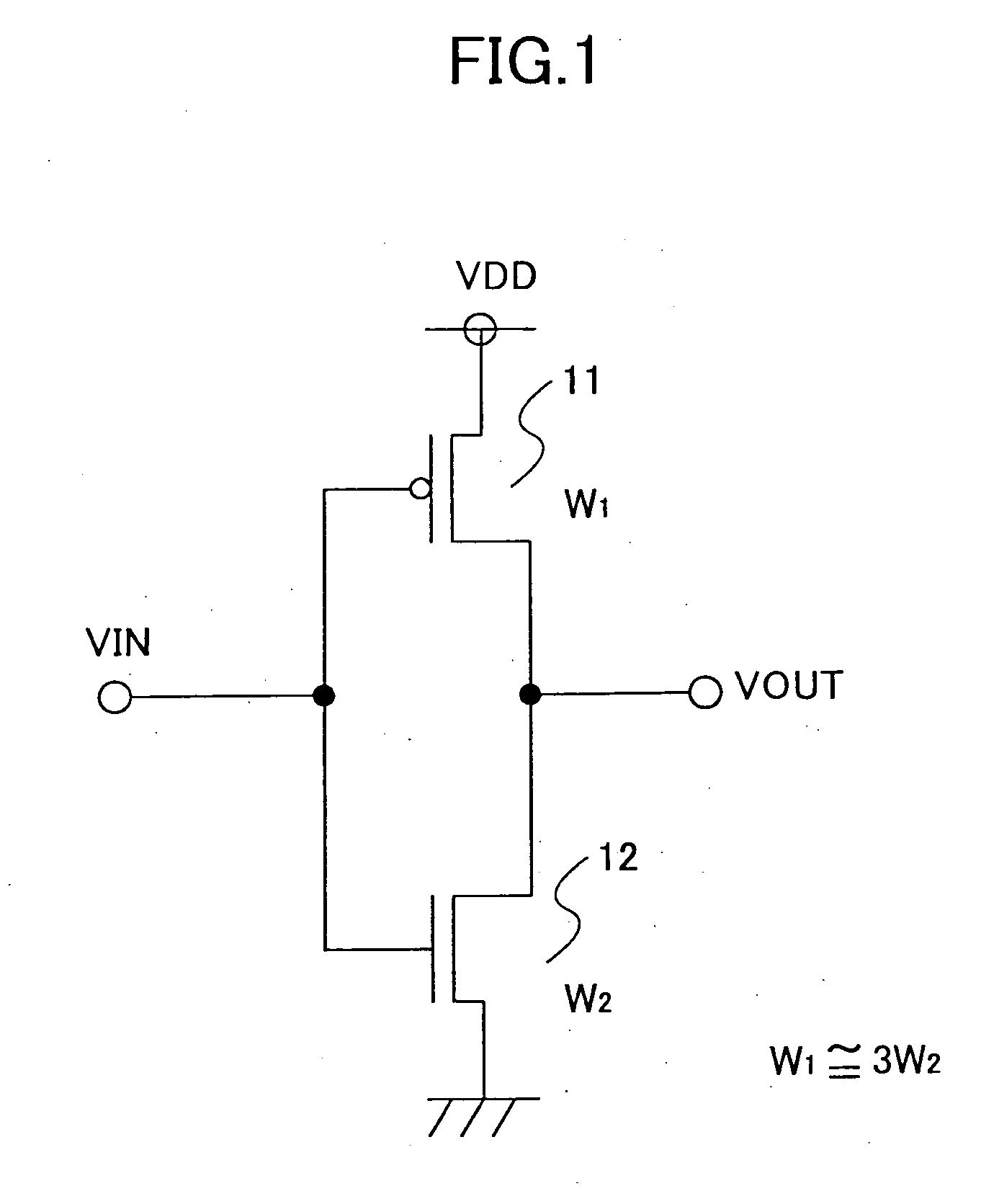Complementary MIS device
a technology of mis-matching and semiconductors, applied in the direction of semiconductor devices, electrical apparatus, transistors, etc., can solve the problems of affecting the operation speed of semiconductor devices, increasing power consumption, and difficulty in wafer handling, so as to achieve the effect of balancing the current drivability
- Summary
- Abstract
- Description
- Claims
- Application Information
AI Technical Summary
Benefits of technology
Problems solved by technology
Method used
Image
Examples
first embodiment
[0056]FIGS. 6 and 7 show the construction of a CMOS device 30 according to a first embodiment of the present invention, wherein it should be noted that FIG. 7 is a diagram showing a part of FIG. 6.
[0057] Referring to FIGS. 6 and 7, the CMOS device 30 is constructed on a Si substrate having a (100) principal surface on which a p-type region A and an n-type region B are formed with a separation from each other by a device isolation region 31C. As represented in FIG. 7, the region A is formed with a projection 31A having a width W1A and a height HA, while the region B is formed with a projection 31B having a width W1B and a height HB at both lateral sidewalls. As can be seen from FIG. 7, the top surfaces of the projections 31A and 31B are defined by the (100) surface, while the sidewall surfaces thereof are defined by the (110) surface.
[0058] On the Si substrate 31 of FIG. 7, a silicon oxide film is formed uniformly by using the substrate processing apparatus 20 explained with refere...
second embodiment
[0067]FIG. 8 shows the construction of a CMOS device 40 according to a second embodiment of the present invention.
[0068] Referring to FIG. 8, the CMOS device 40 is formed on a Si substrate 41 having a (111) surface or a (110) surface as the principal surface and includes an n-channel MOS transistor 40A having a gate electrode 42A extending on the Si substrate 41 in a first orientation and a p-channel MOS transistor 40B having a gate electrode 42B extending on the Si substrate in a second, different orientation. At both lateral sides of the gate electrode 40A, there are formed n-type diffusion regions 43A and 44A. Similarly, p-type diffusion regions 43B and 44B are formed at both lateral sides of the gate electrode 40B.
[0069] Thereby, it should be noted that there is formed a CMOS circuit by connecting the diffusion region 44A and the diffusion region 43B and by connecting the gate electrodes 42A and 42B.
[0070] In the CMOS device of such a construction, it should be noted that the...
third embodiment
[0072]FIG. 9 shows the construction of a three-input NAND circuit that uses the CMOS circuit of any of the foregoing embodiments.
[0073] Referring to FIG. 9, the three-input NAND circuit includes n-channel MOS transistors Tr1-Tr3 connected in series between an output line connected to an output terminal and a ground line, while there are connected p-channel MOS transistors Tr4-Tr6 in parallel between an output line VOUT and a supply voltage source VDD. Thereby, an input logic signal A is supplied to respective gates of the MOS transistors Tr1 and Tr4, while another input logic signal B is supplied to respective gates of the MOS transistors Tr2 and Tr5. Further, an input logic signal C is supplied to respective gates of the MOS transistors Tr3 and Tr6.
[0074] In FIG. 9, it should be noted that the numerals attached to the transistors indicate the relative device area of the respective transistors. Thus, in the case the entire transistors are formed on the (100) surface of silicon, it...
PUM
 Login to View More
Login to View More Abstract
Description
Claims
Application Information
 Login to View More
Login to View More - R&D
- Intellectual Property
- Life Sciences
- Materials
- Tech Scout
- Unparalleled Data Quality
- Higher Quality Content
- 60% Fewer Hallucinations
Browse by: Latest US Patents, China's latest patents, Technical Efficacy Thesaurus, Application Domain, Technology Topic, Popular Technical Reports.
© 2025 PatSnap. All rights reserved.Legal|Privacy policy|Modern Slavery Act Transparency Statement|Sitemap|About US| Contact US: help@patsnap.com



